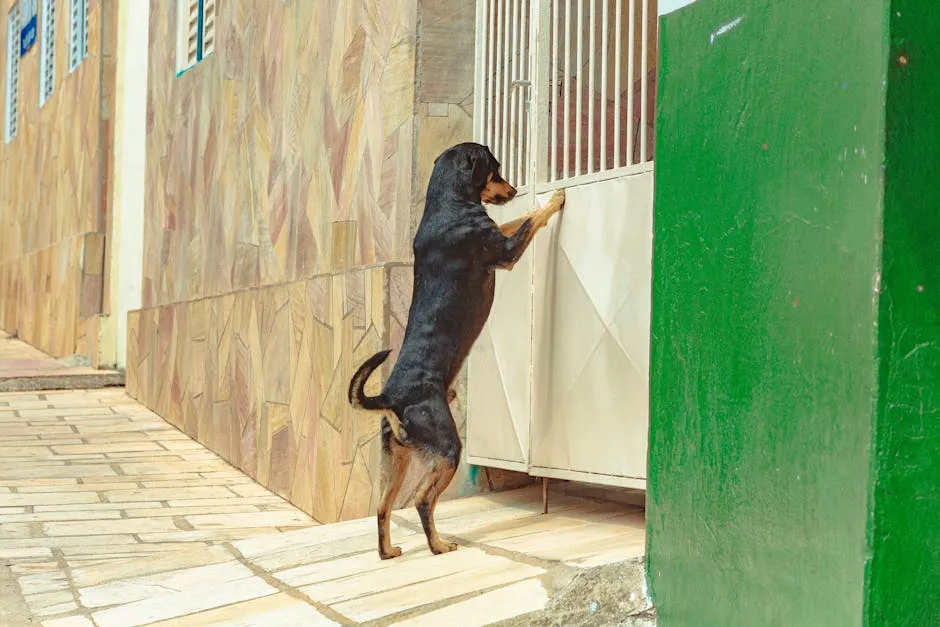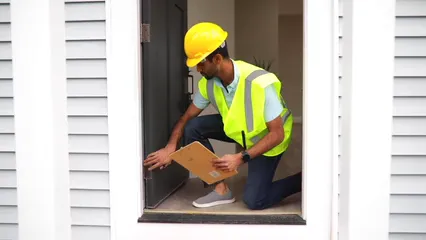Introduction
Dog doors are becoming increasingly popular among pet owners. They provide your furry friends with the freedom to come and go as they please. Plus, they offer convenience for you, allowing you to focus on other tasks. Many modern options also prioritize energy efficiency, catering to various climates.
If your dog is always scratching at the door, it might be time to consider a PetSafe Electronic Pet Door. This door allows your pet to come and go without you needing to get up every time they want to explore the great outdoors. Plus, it’s energy-efficient, so you can save on those pesky utility bills!
Summary and Overview
In this guide, we’ll cover everything you need to know about dog doors. Choosing the right type is crucial. Consider your pet’s size and your home environment to find the best fit. Energy efficiency and weatherproofing are also important features in today’s dog doors. We’ll introduce various styles, from flap doors to electronic options, and highlight the unique features that enhance convenience and security. Whether you have a small pup or a large dog, there’s a perfect door out there for your furry companion.
For more information on different types of dog doors and their features, check out our article on dog doors.
Types of Dog Doors
Door-Mounted Dog Doors
Door-mounted dog doors are popular for many reasons. They are easy to install and fit most home designs. You can quickly create an entry point for your pet without major renovations. Installation usually involves a few basic tools and can often be completed in under an hour.
These doors come in various styles. Flap doors are the most common, providing simple access. They often feature magnetic closures to keep the flap securely in place. Brands like PetSafe and Freedom Pet Pass offer reliable options. If you’re considering an upgrade, the Freedom Pet Pass Dog Door is a top-notch choice that’s built to last!
Security is a key consideration when choosing a dog door. Look for models with locking mechanisms to prevent unwanted access. Some doors also feature electronic options that only open for your pet, ensuring safety.
Overall, door-mounted dog doors provide a practical solution for pet access while maintaining security and accessibility.

Wall-Mounted Dog Doors
Wall-mounted dog doors are a fantastic option for homes with limited door choices. They provide a convenient pet passage without compromising your main entrance. Installing these doors typically involves cutting into the wall and framing the opening, which might require some DIY skills or professional help.
One of the key benefits is insulation. Many wall-mounted doors come with weatherproofing features. These ensure your home remains energy-efficient, keeping out drafts and extreme temperatures. Look for models with insulated flaps for maximum protection. If you want to ensure your furry friend stays comfortable, consider investing in an Insulated Dog Door that will keep the cold air out!
When considering costs, wall-mounted dog doors can be more expensive than door-mounted options. However, the investment often pays off in terms of durability and energy savings. While the initial setup might seem pricier, the long-term benefits, such as reduced energy bills and added convenience, make them a smart choice for pet owners.

Electronic and Smart Dog Doors
Electronic and smart dog doors represent the latest in pet access technology. These automatic dog doors come equipped with features that enhance convenience and safety for your furry friends. One standout feature is remote access. With just a tap on your smartphone, you can unlock the door for your pet.
Many smart dog doors also utilize microchip detection. This means only your pet can gain entry, preventing unwanted animals from wandering in. This feature not only provides peace of mind but also enhances pet safety. If you’re looking for a reliable electronic option, check out the SmartDoor Automatic Dog Door. It’s a game-changer!
Popular examples include the SmartDoor and PetSafe Electronic Pet Door. Both are well-reviewed for their reliability and ease of use. However, keep in mind that security is crucial. Ensure that the door you choose has robust locking mechanisms and is made from durable materials to deter potential intruders.

Key Features to Consider
Energy Efficiency
Choosing energy-efficient dog doors is essential for both comfort and cost savings. These doors help maintain a stable indoor temperature by minimizing drafts. Look for models that use high-quality insulation materials, as this can significantly impact energy usage.
Many energy-efficient doors meet or exceed Energy Star testing standards. They are designed to prevent outside air from infiltrating your home. For example, some dog doors can be 15 times more effective than standard options at blocking air transfer.
In the long run, investing in an energy-efficient dog door can lower your utility bills. Not only do they keep your home comfortable, but they also contribute to a greener environment by reducing energy consumption. Overall, the benefits extend beyond just pet access; they enhance your entire living space.

Weather Resistance
Weather-resistant features in dog doors are crucial, especially in extreme climates. These doors protect your home from harsh elements like wind, rain, and snow. Materials play a significant role in this. For instance, insulated plastic or aluminum options are popular for their durability and thermal efficiency.
Airtight seals are essential for preventing drafts. A well-designed dog door should block outside air while allowing your pet easy access. The DoubleMag™ technology, found in some premium brands, offers an exceptional seal that keeps your home cozy. For those looking for a well-reviewed option, the Weatherproof Dog Door is a solid choice!
Customer testimonials highlight performance in real-world conditions. One user shared how their Freedom Pet Pass door withstood a polar vortex. They noted no noticeable cold air entering their home, even in extreme temperatures. This kind of feedback emphasizes the importance of investing in weatherproof dog doors. Your furry friend deserves the best protection, and so does your home.

Size and Fit
Measuring your dog correctly ensures you choose the right door size. Start by measuring your pet’s height from the ground to their shoulder. Next, measure their width to ensure a comfortable fit.
Popular brands provide size charts to help you find the perfect match. For example, a small door typically fits dogs up to 15 inches tall, while large doors accommodate pets over 22 inches. It’s essential to consider your dog’s breed specifications. Some breeds, like bulldogs, may need extra width for their build. If you’re unsure, check out a comprehensive Dog Door Size Chart for guidance!
A correct fit is vital for both comfort and functionality. A door that’s too small can restrict your pet’s movement. On the other hand, a door that’s too large might compromise security. By measuring accurately, you ensure a safe and convenient entry for your furry companion.

Installation and Maintenance
DIY Installation vs. Professional Installation
When considering dog door installation, you have two main options: DIY or professional help. DIY installation can save you money and offer a sense of accomplishment. You’ll need basic tools like a saw and drill. Many brands provide installation guides, making the process easier.
However, be aware of common pitfalls. Misalignment can lead to air leaks or security issues. If you’re unsure, hiring a professional might be the better choice. The average cost for installation varies, but it typically ranges from $100 to $300, depending on the door type and complexity. To make your installation easier, consider picking up a Dog Door Installation Kit to have all the tools at your fingertips!
Professional installation ensures everything is correctly fitted and sealed. Plus, it saves you time and potential frustration. Ultimately, weigh your skills and budget to decide the best route for your dog door installation.

Maintenance Tips
To keep your dog door in top shape, regular maintenance is key. Start by cleaning it frequently. Use mild soap and water with a soft cloth to wipe down the flap and frame. Avoid harsh chemicals that could damage the materials.
Next, inspect the door regularly for wear and tear. Check the flap for cracks and the hinges for rust. If you notice any issues, address them promptly to prevent further damage. A well-maintained door can save you from needing costly replacements down the line, so don’t neglect it!
Common problems include the flap sticking or not closing properly. If this happens, adjust the hinge screws or clean the track to ensure smooth operation. You might also need to replace worn-out seals to maintain energy efficiency. A handy Dog Door Seal can also help improve insulation and efficiency.

FAQs
What is the best dog door for extreme weather conditions?
If you live in an area with harsh weather, choose a dog door designed for insulation and weather resistance. Look for options that feature insulated flaps and airtight seals. A top contender is the RANGER pet door by Freedom Pet Pass. It has been tested to be 15 times better at preventing outside air infiltration than standard Energy Star models. This door ensures your home stays cozy, even in extreme cold or heat.
How do I measure my dog for a dog door?
Measuring your dog is crucial for selecting the right door size. Start by measuring your dog’s height from the ground to their shoulder. Next, measure their width for a comfortable fit. Consider adding a couple of inches to both measurements for extra room. Most brands provide sizing charts to guide you. Ensuring a proper fit guarantees easy access for your furry friend and keeps unwanted animals out.
Are electronic dog doors worth the investment?
Electronic dog doors offer convenience and security. They allow your pet to enter and exit without needing you to open the door. Many models use smart technology, like microchip detection, ensuring only your pet can access the door. However, consider the cost against your budget and needs. While they can be pricier, the added safety and ease of use often make them a worthwhile investment.
Can I install a dog door in a wall?
Yes, you can install a dog door in a wall, but it requires specific considerations. Wall-mounted dog doors typically need framing and insulation to maintain energy efficiency. Ensure you have the proper tools and skills, as this can be more complex than installing a door-mounted option. If you’re unsure, hiring a professional can save you time and guarantee a secure fit.
What maintenance is required for dog doors?
Regular maintenance is essential for keeping your dog door functional. Clean the flap and frame with mild soap and water to remove dirt and debris. Check seals for wear and tear regularly. If you notice issues like sticking flaps or air leaks, adjust or replace components as needed. Routine checks help prolong the lifespan of your door and ensure it remains energy-efficient.
Where can I find energy-efficient dog doors?
You can find energy-efficient dog doors at various retailers, both online and in stores. Look for brands that highlight insulation and energy-saving features. Websites like Freedom Pet Pass and PetSafe offer a range of options. Always read customer reviews to ensure you choose a reliable product that meets your energy efficiency needs.
Do dog doors pose a security risk?
Dog doors can pose security risks if not chosen carefully. Look for doors with strong locking mechanisms and durable materials. Electronic options provide added security by using microchip technology, allowing only your pet access. Additionally, consider the door’s design to ensure it fits snugly in the opening, minimizing potential intruder access. Always prioritize safety features when selecting a dog door.
Please let us know what you think about our content by leaving a comment down below!
Thank you for reading till here 🙂 If you’re also looking for ways to keep your pet hydrated, consider a Pet Water Fountain. It’s a great way to encourage your pet to drink more water!
All images from Pexels





